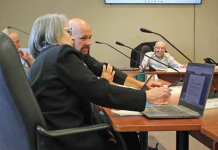The County of Haliburton has committed $20,000 towards a rural transportation pilot project being championed by SIRCH, City of Kawartha Lakes (CKL) Human Services and Fleming CREW.
County councillors gave the green light to the funding at their committee of the whole meeting April 13.
While initially the pilot will assist people to get to and from SIRCH for training programs, and people on Ontario Works (OW) and Ontario Disability Support Programs (ODSP) to meetings and appointments, it could evolve to help the County sort its need for public transportation, County CAO Mike Rutter said at the meeting.
The partners have already leased an eightpassenger van and hired a driver. The cost will be free for SIRCH trainees during training and for three months after.
Janine Mitchell, manager of human services for CKL, presented to council.
“We’re really quite excited about the potential to provide increased access to participate in either Ontario Disability Support Programs and services or employment-related services and programs,” she said.
She said Shanthi Rajaratnam of Fleming CREW identified the ongoing problem, particularly in Haliburton County, and SIRCHs Gena Robertson quickly jumped on board for the pilot project. In SIRCH’s participation service proposal, they noted “one of the biggest hurdles to providing training in Haliburton County is the lack of public transportation.” They added people on low income generally can’t afford to live in Haliburton village but on back roads many miles from town. Potential trainees might not be able to afford a vehicle and its related costs and taxi fares are heading towards $2.50 per kilometre.
Lack of transportation hurdle to training
The driver is specifically trained to be knowledgeable about programs and is expected to help people find ride shares, get their licences and perhaps their own transportation one day.
When not driving SIRCH trainees in the morning and afternoon, the driver is free for CKL clients.
The proposal put the cost at $67,960 excluding cost recovery for OW and ODSP clients, ranging from $8 for rides up to 10km and $50 for trips of 60 to 100km.
Mitchell said the lack of public transportation was identified in the County’s community safety and well-being plan.
Rutter said he thought the pitch was “very timely.” He said the County had about $200,000 in a transportation reserve as past councils had identified public transportation as a challenge, and need, but had been “waiting for a model or a service delivery model that would work in the County of Haliburton and we continue to investigate those.”
He noted first-year projects are not eligible for provincial gas tax funding but they are in second and subsequent years.
Coun. Andrea Roberts called the project “exciting. I love the marriage of finding a need and the service matching that.”
Coun. Brent Devolin lamented that two terms of council were unable to deliver some form of public transportation and said this might help with some of the Highlands’ “labour force woes”. He also took a swipe at Fleming College for failing to establish a trades school in the County.
Coun. Pat Kennedy said he was interested in how they would navigate logistics. “Trying to get six people to work for 9 o’clock in the morning … I’m really looking forward to seeing how you work that one out all over the County.” However, he felt it was money well spent.
Coun. Cec Ryall asked about looking into alternate training sites as Haliburton village might not work for all future training. Mitchell said they would look into it.
Rutter said, “the really interesting thing about this pilot is we’re not sure where it will take us eventually but at least we are doing something … and there are other things we can do in the meantime.”
He mentioned that he and director of economic development, Scott Ovell, met with a group piloting on-demand transit services based on sophisticated algorithms and technology that predict routes and demand. “They believe in a rural community like this, that can be a really valuable tool. I really think there is potential to see a real evolution of transit in the County using this as a springboard,” Rutter said.




